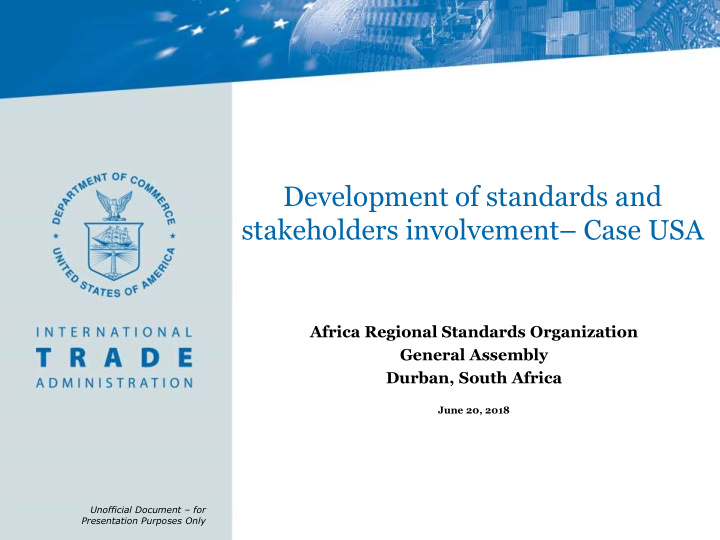



Development of standards and stakeholders involvement – Case USA Africa Regional Standards Organization General Assembly Durban, South Africa June 20, 2018 Unofficial Document – for Presentation Purposes Only
International Trade Administration (ITA) Mission • strengthens the competitiveness of U.S. industry • promotes trade and investment • ensures fair trade through the rigorous enforcement of our trade laws and agreements • works to improve the global business environment • helps U.S. organizations compete at home and abroad 2
Why Standards Matter
Findings: Goods Exports Covered by WTO Notifications 92.9 % of world exports (2014) C a t e 91.7 % g of U.S. exports o r y (2015) 1 0% 25% 50% 75% 100% Calculations based on WTO notifications from January 1, 2006 to August 18, 2015 by all WTO members (Source: Okun- Kozlowicki, “Standards and Regulations: Measuring the Link to Goods Trade,” June 2016) 4
U.S. Standards Approach • Private sector-led, market driven and multi-path • Often sector specific • ANSI coordinates U.S. system • Decentralized -250 standards development organizations (SDOs) • Open participation, including non-U.S. • Most other countries have a “top down” approach
U.S. Standards Approach • National Technology Transfer and Advancement Act (NTTAA) • OMB Circular A-119 • EOP Memo M-12-08 Policy Principles for Federal Engagement in Standards Activities to Address National Priorities, White House Memo 2012 • National Institute of Standards and Technology (NIST) 6
Standards Development and Stakeholders Involvement • Escape Rescue Systems • U.S. Government Approach to Building a 21st Century Grid • Regional Cooperation – APEC 7
Standards Development and Stakeholders Involvement Escape Rescue Systems • External elevator for emergency evacuation in high rise building • Clients and regulators said - need a recognized standard • Identified National Fire Protection Association and ASTM • Formed ASTM technical subcommittee • Standards Institution of Israel. • CEO became chairman of the technical subcommittee • The Subcommittee approved the standards; NFPA incorporated into its codes Source: ASTM International
Standards Development and Stakeholders Involvement Escape Rescue Systems Benefits: • Market acceptance - Clients, regulators and labs accepted the innovative technology • Standards serve to develop improvements and next generation • Enables subcontracting manufacturing • Doing business in Israel, India and South Korea Source: ASTM International
Standards Development and Stakeholders Involvement US Government Approach to Building a 21st Century Grid • Energy Independence and Security Act 2007 (EISA) • National Institute of Standards and Technology (NIST) coordinate the development of a framework for interoperability. • 2009 Secretaries of Commerce and Energy convened industry • NIST hosted 3 public workshops with 1500 participants, published 3 separate Federal Register notices, and utilized a web-based collaboration site (i.e., a “wiki”). • NIST Framework and Roadmap for Smart Grid Interoperability Standards, 1.0., 2.0. 3.0 • NIST created the Smart Grid Interoperability Panel (SGIP). • NIST and SGIP created a Catalog of Standards and NIST's "Identified Standards“ – multiple standards
Standards Development and Stakeholders Involvement US Government Approach to Building a 21st Century Grid NIST Smart Grid Interoperability Plan PHASE 1 Stakeholder NEXT CHAPTER Initial PHASE 2 Outreach Private-Public Framework Public-Private “New” Smart Grid and Smart Grid Domain Interoperability Standards Interoperability Expert NIST Panel (2.0) based on Panel (SGIP) Staff and Working Summer Research Groups NIST Smart Grid 2009 PHASE 3 & Stds workshops, Research & (w/ Testing & finalized Standards Program GWAC) Certification Jan2010 NIST / Grass Federal Advisory Roots Committee Input Support 2010 & 2013 and on 2009 2012 2008 2011
Standards Development and Stakeholders Involvement US Government Approach to Building a 21st Century Grid SGIP 2.0, Inc. – Board of Directors Executive Committee Stakeholder Category Executive Director Elected Directors (25) • Administrative, • Chair, Vice- Audit Committee Marketing & Chair, Operation support Secretary, SGIP Membership & Treasurer Marketing Products Committee Ex-officio Elected Chairpersons Nominating & Conceptual Model Governance Committee Ex-officio Ex-officio Ex-officio Ex-officio Ex-officio Ex-officio Ex-officio & Roadmaps Technical Committee Requirements Use Cases Government Program Management Office (PMO) Implementation Methods (SGIMC) Agencies Testing & Certification (SGTCC) Coordination functions • NIST White Papers Cybersecurity (SGCC) • DOE Architecture (SGAC) • FERC H2G B2G SGIP Member Groups Standards Reviews I2G TnD International BnP V2G PAP 1 PAP 2 LOIs/MOUs Catalog of Standards • Korea DRGS Gas • Europe PAP 3 PAP… • Japan EMII Priority • Ecuador Standing Action Plan • Colombia Committees Working Groups (PAP) Teams • Brazil & Working Groups 12
Standards Development and Stakeholders Involvement Facilitating trade in cybersecurity technologies & services Regional Cooperation – APEC Platform • APEC • Workshops – underscores benefits of a multi-stakeholder approach Stakeholders • Sub Committee on Standards and Conformance (SCSC) prioritizes standards and conformance to support the digital economy • APEC SCSC and TEL to engage stakeholders • APEC and ASEAN Government cybersecurity regulators, national standards bodies, standards development organizations • Industry representatives Output • Application of Globally-recognized cybersecurity standards in the region facilitates trade • Promotion of interoperable cybersecurity frameworks supports commerce 13
Standards Alliance • Public Private Partnership – USAID + ANSI • Reflects public-private model of the U.S. system, leveraging access to expertise in the U.S. private sector and government agencies for project activities • Assists developing countries implement WTO’s Technical Barriers to Trade (TBT) agreement • Code of Good Practices for the adoption and application of Standards • Promote trade and economic development • 15 countries/regions: Initiated with ten (10) participating countries: CAFTA-DR, Colombia, EAC, Indonesia, Mexico, MENA, Peru, SADC, Vietnam, Yemen • Expanded in 2016 to include 5 additional African countries - Cote D’Ivoire, Ghana, Senegal, Mozambique and Zambia
Thank you! Everett Wakai Senior Commercial Officer U.S. Commercial Service, American Embassy - Angola everett.wakai@trade.gov www.export.gov/
Recommend
More recommend